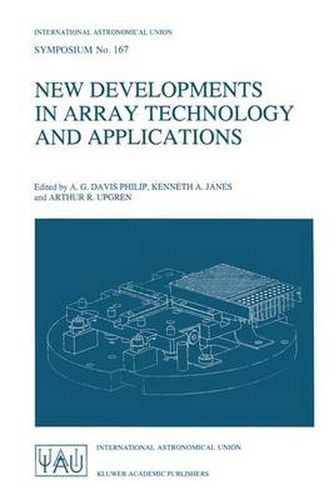Readings Newsletter
Become a Readings Member to make your shopping experience even easier.
Sign in or sign up for free!






This title is printed to order. This book may have been self-published. If so, we cannot guarantee the quality of the content. In the main most books will have gone through the editing process however some may not. We therefore suggest that you be aware of this before ordering this book. If in doubt check either the author or publisher’s details as we are unable to accept any returns unless they are faulty. Please contact us if you have any questions.
This IAU Symposium brought together researchers who use CCDs and arrays, designers and manufacturers of CCDs and array mosaics, and those who write the software to control these devices and to reduce the large amounts of data contained in each frame. At the meeting such topics as plans for applying the new technology to the new large telescopes that have been built recently and those planned in the near future, new developments in infra-red arrays, advances and concerns with the use of CCDs in photometry and spectroscopy and the creation of large mosaics in photometry and spectroscopy, and the creation of large mosaics of chips which allow larger areas of the sky to be covered in a single frame were discussed. There were sessions devoted to the following topics: new developments in CCD technology; new developments in IR detector arrays; direct imaging with CCDs and other arrays; spectroscopy with CCDs and other arrays; and large field imaging with array mosaics. Scientific results of studies made with this technology were covered in the poster sessions. CCD and array detectors have become the detectors of choice at all the world’s optical observatories. Such instruments on small university and college telescopes have turned these telescopes into instruments that can now do observations which in the past were done only on the largest telescopes. CCDs and arrays are known as the people’s detector because of their ability to turn small telescopes into true research instruments. On large telescopes observations can be made of extremely faint and crowded objects that were impossible to observe before the advent of CCD and Array technology. The proceedings of this meeting should be useful to all those who are interested in the design, manufacture and use of CCDs and arrays for astronomical observations.
$9.00 standard shipping within Australia
FREE standard shipping within Australia for orders over $100.00
Express & International shipping calculated at checkout
This title is printed to order. This book may have been self-published. If so, we cannot guarantee the quality of the content. In the main most books will have gone through the editing process however some may not. We therefore suggest that you be aware of this before ordering this book. If in doubt check either the author or publisher’s details as we are unable to accept any returns unless they are faulty. Please contact us if you have any questions.
This IAU Symposium brought together researchers who use CCDs and arrays, designers and manufacturers of CCDs and array mosaics, and those who write the software to control these devices and to reduce the large amounts of data contained in each frame. At the meeting such topics as plans for applying the new technology to the new large telescopes that have been built recently and those planned in the near future, new developments in infra-red arrays, advances and concerns with the use of CCDs in photometry and spectroscopy and the creation of large mosaics in photometry and spectroscopy, and the creation of large mosaics of chips which allow larger areas of the sky to be covered in a single frame were discussed. There were sessions devoted to the following topics: new developments in CCD technology; new developments in IR detector arrays; direct imaging with CCDs and other arrays; spectroscopy with CCDs and other arrays; and large field imaging with array mosaics. Scientific results of studies made with this technology were covered in the poster sessions. CCD and array detectors have become the detectors of choice at all the world’s optical observatories. Such instruments on small university and college telescopes have turned these telescopes into instruments that can now do observations which in the past were done only on the largest telescopes. CCDs and arrays are known as the people’s detector because of their ability to turn small telescopes into true research instruments. On large telescopes observations can be made of extremely faint and crowded objects that were impossible to observe before the advent of CCD and Array technology. The proceedings of this meeting should be useful to all those who are interested in the design, manufacture and use of CCDs and arrays for astronomical observations.